Cricket grounds lit up by the stars
By A. C. De Silva
CRICKET GROUNDS: The cricket grounds the world over have interesting
stories connected with them that goes to show how important it is to
keep the grounds in good order. From venerated Victorian antiquities to
the brand new concrete stadia, the grounds of the world are the stages
upon which the drama of cricket is played out. Close on 100 venues have
hosted Test cricket, while as many again have been the venue for one-day
internationals. Cricketing stars from Sir Donald Bradman down the line
lit up the grounds with marvellous feats.
|
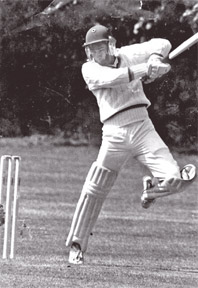
Sidath Wettimuny – Made a pleasing score of 190 in August
Test against England at Lord’s in 1984. |
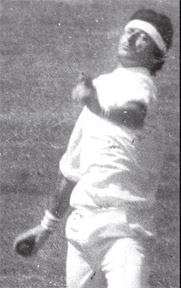
Sir Richard Hadlee 7 for 23 – best bowling analysis vs India in 1975-76 |
For a variety of reasons including history, size location and
significance, some grounds stand out. The majesty of Lord's, the
atmosphere of the Wanderers in Johannesburg, the history of the Sydney
Cricket Ground or the energy of Eden Gardens, Kolkatta; on such great
grounds are the most important matches played. Their characteristics
enhance, indeed often define the occasion, which is why they feature so
prominently in cricket's history.
Bradman in full flow
Cricketers all over the world want to play at Lord's and players from
overseas are often inspired by the setting and the occasion to give of
their very best. It is therefore perhaps no coincidence that some of the
most notable Test records on the ground belong overseas. Australia
compiled the highest score in 1930, as Bradman - the world's greatest
batsman and Woodfull contributed greatly to a total of 729 for 6 wickets
declared.
Another Australian - Bob Massie, achieved the best match analysis of
16 for 237 in 1972 by bending the ball round the corners. Against that
trend, Ian Botham holds the best innings analysis with 8 for 34 against
Pakistan in 1978, while Graham Gooch's Symmetrical 333 against India in
1990 set a new mark for an individual innings.
India have the unhappy distinction of making the lowest Test score on
the ground - 42 in 1974.
Melbourne - Test cricket oldest
|
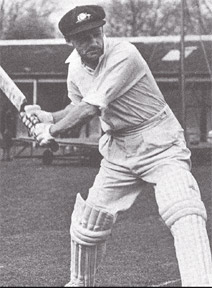
Sir Donald Bradman - the world’s greatest batsman
|
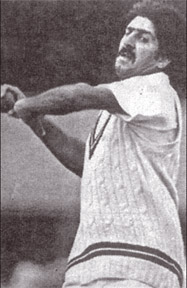
Saffraz Nawaz of Pakistan had fine figures of 9 for 86
against Australia in the 1978/79 series
|
The ground with the highest official capacity is also Test cricket's
oldest. The first such match took place in Melbourne, Victoria, back in
1877 and it started when Alfred Shaw bowled the first ball to Charles
Bannerman, who went on to complete the first Test century. Although it
has always been known as the Melbourne Cricket Ground, Australian Rules
Football has been a partner sport, ensuring constant use for one of
Australia's main sporting arena. The Olympic Games were held there in
1956, and the Commonwealth Games 50 years later, Soccer, Rugby, Tennis,
Bowls, Lacrosse, Athletics, Cycling, and Hockey can be listed among a
host of activities staged there since permission was first granted for
part of "Police Paddock" to be used as a ground in 1853.
When the MCG staged the World Cup final of 1992, a new Great Southern
Stand was opened. It holds some 50,000 people, very nearly as many as
Lord's and the Oval combined. The development made it a multi-sports
stadium rather than a cricket ground, but it justifies its place as one
of the great venues in the cricket world with a capacity of over 96,000.
Australia have twice reached totals of 600 here, and both times
England were their hapless opponents, They rattled up 604 in 1936/37,
and exactly 600 in 1924/25. To counter that, Australia bowled out South
Africa for 36 and 45 in 1931/32. In 1965/66 Bob Cowper, himself a
Victorian, scored 307 against England to pass the mark 270 set by Sir
Donald Bradman in 1936/37 in that total of 604. Such batting feats
dettered neither Safraz Nawaz of Pakistan when he too 9 for 86 against
Australia in 1978/79, nor Wilfred Rhodes who had match figures of 15 for
124 for England in 1903/04. Like the MCG. Australia's other major
grounds have remained fairly constant throughout the games's history.
Test cricket first in Brisbane
|
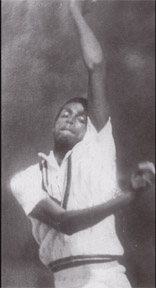
Courtney Walsh of West Indies had 13 wickets for 55 runs in
1994/95 series.
|
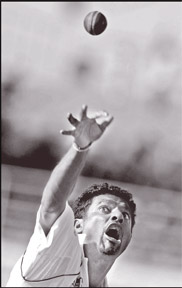
Muttiah Muralitharan – World Bowling record of 800 wickets
in 133 Tests and 534 wickets in 350 ODIs.
|
Test cricket was first played in Brisbane in 1928 on the Exhibition
Ground, rather than at Weelleengabba (the Gabha) as it has been since
1931. New Test ground have been introduced in Darwin, Cairns and Hobart
in recent years, but the main arenas, apart from Melbourne and Brisbane,
remain Sydney, Adelaide and Perth.
As might be expected, there are fewer Test grounds in New Zealand
than Australia.
England beat New Zealand easily
The first Test in New Zealand was played at what was then Lancaster
Park, and is now known as the Jade Stadium, Christchurch in 1930 when
England, chasing only 63 runs in their second innings, won by 8 wickets.
Auckland is another rugby ground used to stage Tests, as is Dunedin.
Napier became a Test venue in 1979, while Hamilton was added to the list
in 1991.
Perhaps new Zealand's most notable Test ground is the Basin Reserve
in Wellington, because it is used simply for cricket. Built on land
flattened by an earthquake in 1855, it forms a giant traffic roundabout.
For that reason access is not easy, but once inside, you sense a calm
and tranquility that reminds of cricket.
New Zealand holds the record for the highest total there, 671 for 4
wickets against Sri Lanka in 1990/91, and the lowest, 42 against
Australia in 1946/47. It was during the former innings that Martin Crowe
scored 299, coming tantalisingly close to being the first New Zealand to
make a triple hundred in Tests. Sir Richard Hadle has the best innings
bowling analysis of 7 for 23 against India in 1975/76, but while he took
11 wickets in that match, the West Indian Courtney Walsh managed 13 for
55 in 1994/95.
Test cricket - 11 grounds in South Africa
Test cricket has been played at 11 grounds in South Africa. In the
early days, matches were played on matting wickets and South Africa's
first Test, at St.George's Park, Port Elizabeth in 1889, was played on
such a surface. Any notion that the home team might be at an advantage
was quickly dimissed, as were South Africa, twice. They lost to England
by 8 wickets, with the match all over by half past three on the second
day.
|
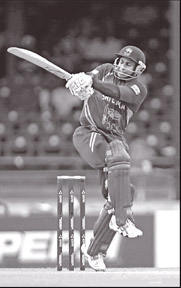
Sanath Jayasuriya – Hit a superb knock of 340 runs in the
record-breaking total of 952 for 6 wickets against India at
the Premadasa Stadium in 1997. |
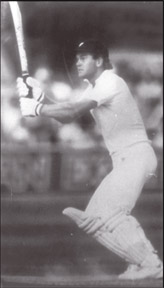
Martin Crowe – Scored 299 in Kiwis score of 671 for 4 wkts
in 1990/91 vs Sri Lanka.
|
There was a time when South Africa played home Tests at Lord's. Four
matches were played at a ground bearing the name in Durban, before Natal
and then South Africa moved to Kingsmead. Three venues have been used in
Johannesburg. The Old Wanderers was in use between 1896 and 1946, but
just as Thomas Lord had to move his ground in London to make way for
Johannesburg railway station. Test cricket moved to Ellis Park between
1948 and 1954 before that stadium was devoted entirely to rugby,
following the opening of the (New) Wanderers in 1956.
The ground is known as "Bull Ring", and a walk to middle illustrates
why. Forsaking the sanctity of the pavilion, players walk down a tunnel
to reach the outfield. Immediately there is a gladitorial atmosphere
that is magnified on reaching the middle.
Not far from Johannesburg, a new stadium was build at Centurion. It
hosted its first Test in 1995, and provides fine facilities with high,
grassy banks affording a splendid view of play but little protection
from frequent mid-afternoon thunderstorms. Buffalo Park in East London
also has a vast, grassy bank for spectators and is attractive like many
South African grounds, but none can match Newslands at Cape Town.
As recently as 2003, South Africa established a new record of 620 for
7 wickets there against Pakistan, as Herschelle Gibbs compiled the
highest individual score of 228. Conversely, South Africa have been
bowled out there three times for less than 50. England were their
tormentors on all three occasions in the 19th century with 35 in 1899
the lowest.
Further north, Zimbabwe has no claim to a great ground, despite the
charm of the Harare Sports Club in the country's early days of Test
cricket. While Bangladesh can boast bustling stadia to match several on
the sub-continent, but none lingers especially long in the memory. Time
and improving playing standards might elevate the Bangladeshi grounds to
a level where they can match those of Sri Lanka.
Sidath , Murali and Sanath top performers
In Sri Lanka most Test cricket has been played in Colombo. However,
efforts are now being made to take Tests outside the capital. The
Aussies are playing their first Test against Sri Lanka at the Galle
International Stadium and that match is scheduled to end today.
The Second Test scheduled to be played from September 8 to 12 at the
Pallekelle Stadium and the third Test will be at the SSC grounds at
Maitland Place.
Tests have also been played at Asgiriya International Stadium - the
ground belongs to Trinity College, Kandy.
Sidath 190 at Lord's
Sidath Wettimuny had the distinction of making 190 in the inaugural
Test at Lord's in 1984 in Sri Lanka's total of 491 for 7 wickets
declared. Duleep Mendis made 111 and Arjuna Ranatunga 84. There was
Muttiah Muralitharan with a number of bowling records and Sanath
Jayasuriya - the attacking batsman made a majestic knock of 340 in world
record total of 952 for 6 wickets in 271 overs in 1,126 minutes at the
Premadasa Stadium.
Tests at 16 grounds in Pakistan
No fewer than 16 grounds have staged Test cricket in Pakistan. The
first home Test played in Pakistan was staged in what is now Bangladesh
but was then East Pakistan. The Decca Stadium hosted a drawn match
against India in 1955. India too can boast of 19 grounds where Tests
have been played. It is said that cricket politics have somewhat been
responsible in the distribution of Tests.
The first Test played in India was at the Gymkhana in Bombay (now
Mumbai). The land on which the Brabourne Stadium was built had been
reclaimed from the sea and was given to the Cricket Club of India by the
Governor of Bombay Lord Brabourne. It staged its first Test in 1948.
But due to some internal problems Bombay Cricket Association built
its own ground less than a mile away. Test matches moved to the new
Wankhede Stadium in 1975.
Gavaskar and Tendulkar - the stars
There has been some great matches in India with the Second Test
between India and Australia in 2001 standing out as one of the best of
all time.
After bowling out India for 171 to claim a first innings lead of 274,
Australia enforced the follow-on. India responded by compiling the
highest score on the ground - 657 for 7 wickets declared before bowling
out Australia for 212 to complete an outstanding 171-run victory. In the
second innings, V.V.S. Laxman hit up a superb 281. The lowest in India
in Tests came in 1983 when the West Indies fast bowlers scuttled India
out for 90.
Lance Klusener of South Africa has recorded the best analysis with 8
for 64 in 1996, while Javagal Srinath claimed the best match figures
with 13 for 132 against Pakistan in 1999. However, despite his efforts,
Pakistan won the match. Two of the Indian cricketers who will never be
forgotten are Sunil Gavaskar and Sachin Tendulkar - both batsmen
thrilled the crowds.
Sobers and Lara unforgettable
Coming over to the West Indies there are many grounds that are really
beautiful. St. John's Recreation Ground in Antigua became a Test venue
quite recently - 1981 when Antigua's favourite cricketer Viv Richards
marked the occasion with a swashbuckling century against England.
For many years Antigua's first Test player and fearsome fast bowler
Andy Roberts, was the groundsman, yet he produced pitches to favour
batsmen. That is why Brian Lara was twice able to break the record for
the highest individual Test score there. In 1994 Lara passed Gary Sobers
with 375 against England, and he followed that a decade later by
reclaiming the record from Mathew Hayden with an innings of 400 not out,
against the same opposition.
|

